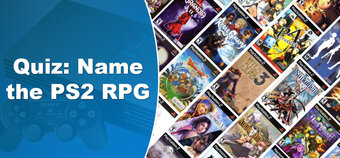Looking back on it now, it doesn't seem all that long ago that everyone was bigging up virtual reality headsets as being a complete 'game changer' for the industry - this year's 'must buy' tech item that everyone just had to have. Yet now, all of a sudden, the hype seems to have fizzled out just as quickly as it began. And while we had a hunch that VR might not prove as popular as people had hoped, we can't deny the allure virtual reality has, letting you immerse yourself in game worlds much more fully than just by sitting on your sofa, controller in hand and cat on lap.
It's also kind of cool in a sci-fi style way - and it's this mysterious allure that forms the basis of anime/manga series, Sword Art Online. Set in a fictional massively multiplayer online role playing game (MMORPG), Sword Art Online told the story of a game gone bad - where players who donned the VR headsets soon discovered they were trapped in the virtual world, and dying in game would mean they'd die in real life too. According to the sinister being who trapped them there, the only way to get out alive was to clear all 100 floors.
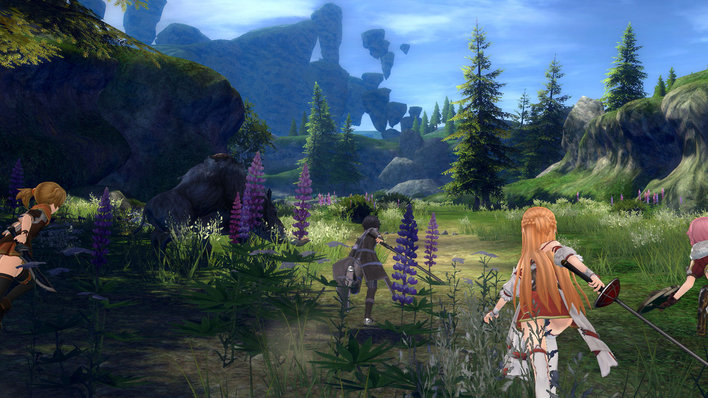
There's a very pretty world waiting to be explored.
While you'd think they might be a little bit more cautious about the whole "virtual reality MMO that promises the world" idea after the first time round, Sword Art Online: Hollow Realization sees main stars Kirito, Asuna, and the rest of the crew dive into another virtual reality game, this time taking part in the beta test for Sword Art Origin. Rising from the ashes of the original Sword Art Online game, but without whole trapping-folks-in-a-game-where-dying-in-game-means-dying-in-real-life thing, Origin is set in the new world of Ainground - a land which looks different, yet familiar at the same time.
During their first few hours in the new game, Kirito and co bump into an unknown NPC (or, non-player character), who appears to be suffering from some sort of amnesia. With no idea who she is, what her purpose is, or even what her name is, all she can do is take people on a basic quest that's more than a little bit dull, where they escort her to a featureless location in game, and earn 1 single col (the game's unit of currency) for their trouble. Taking her in under their wing, the team are determined to find out who she is, and what her meaning is in the game - all whilst enjoying the fact that the game isn't out to kill them this time.
Less foreboding than the prior games, without the constant sword of Damocles hanging overhead, Hollow Realization instead leads with a much more light-hearted tale of a bunch of teenage friends messing about in an online world. We should probably note, though, that Hollow Realization is definitely one best reserved for those who've watched the anime, as it's full of references to past events and characters that those not well versed in the lore won't really understand - not to mention huge, gigantic plot spoilers!
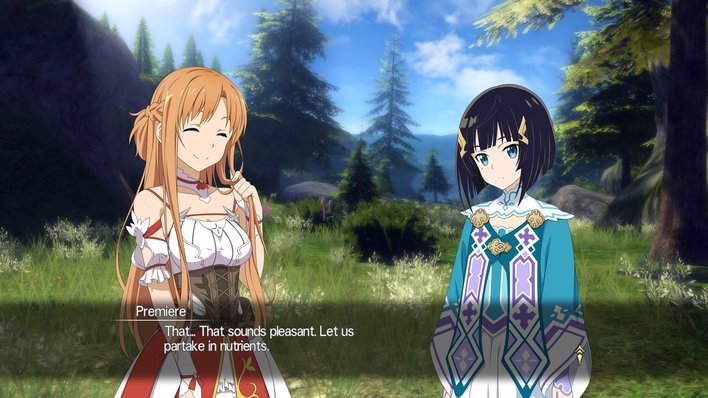
Premiere really has a way with words...
Much like the anime it's based on, Sword Art Online: Hollow Realization is a role-playing game, with a distinctly 'MMO' (Massively Multiplayer Online) flavour. With many a quest to complete, dungeon raids to partake in, and towns, forests and caves to explore, you'll actually regularly find yourself coming across bands of other adventurers in game, who'll be taking on enemies, milling around, or otherwise going about their own business. For anyone who's ever dabbled in World of Warcraft, Runescape or Guild Wars, it'll be a familiar sight - yet in Hollow Realization, these aren't actually real people, but instead are simply computer controlled characters that are effectively part of the scenery, as this is an offline recreation of an MMO - and a really well done one at that.
However, while it is mostly intended as a single player, offline adventure, there is a multiplayer mode here too - once you've completed the game's rather lengthy prologue and beaten your first boss, you can take some of your real-life pals along for the ride, with support for up to four players online.
As with any role-playing game, most of your time in Hollow Realization will be spent out on various quests and missions, playing your way through the game's winding story. When you're not watching pretty lengthy, visual novel style cutscenes and events in town, you'll be out exploring the game's forests, caves and dungeons, whether you're in search of the materials to make gunpowder, on a quest to slay monsters, or out on a jaunt to help Premiere figure out her true purpose.
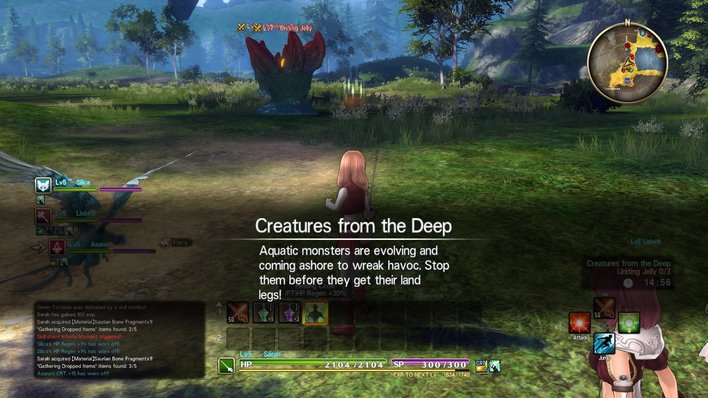
You'll also sometimes come across random events while in the field - complete these for a nice XP bonus
While the game itself may default to putting you as Kirito, the protagonist from the anime, there's also a pretty extensive character creator here you can use, letting you customise almost everything about your character, from sex and hair colour, to voice and preferred weapon type. However, no matter what voice you choose, whether male or female, certain cutscenes will still see your character speaking in Kirito's voice, which can be more than a little bit jarring at first.
Despite what Hollow Realization's whirlwind and overwhelming tutorials would have you believe, the battles here are actually fairly straight-forward, button mashing affairs. With no fancy transitions or battle areas, the enemies you see while out and about are the enemies you'll face, and you can either choose to simply run past them, or whack 'em with your weapons.
Depending on the weapon you have equipped, you'll have access to a different set of attacks and skills. With weapons ranging from bog standard swords and rapiers to hulking great two-handed axes or clubs, you can mix up your physical attacks with a range of unique skills, from simple healing spells, to forceful sword thrusts, to even turning invisible for a short time - although how you choose which power you want to do is a little bit unusual.
All the skills you've unlocked so far are stored in a grid at the bottom of the screen called the 'palette' (much like in a traditional MMO), and at the touch of a button, you can switch control to the palette, to select the move you need. It does take a bit of getting used to, but if you arrange it so your commonly used skills are in a row, even finding them in the middle of a battle isn't all that tricky. Even better, from time to time, you can use your skills to trigger an even more powerful move - if you sync things with your party, so that you each fire off a skill one after the other, you'll trigger a bonus, mega-damage move, which is perfect for taking down bosses. Learning to exploit this 'skill allied' system is the key to taking down strong enemies swiftly, although it does take a bit of getting used to at first.
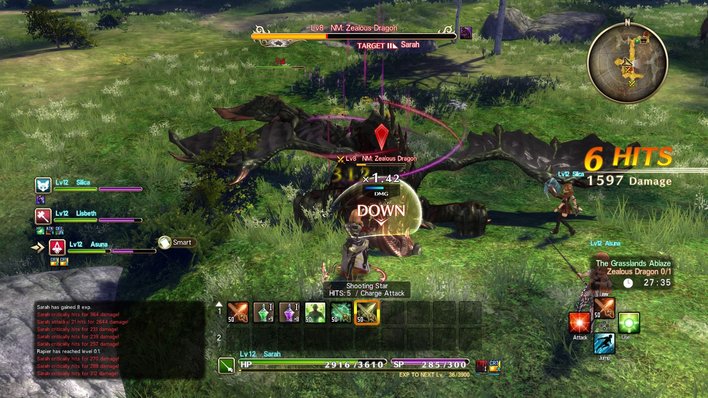
Battles may look complex, but once you get the hang of it it's really not that bad.
Of course, most enemies won't just sit there and let you beat them up without retaliating, and you won't want to get in the way of too many of their attacks. Luckily, Sword Art puts some nice big red markers around the enemies' feet when they're charging up a particular attack, showing you exactly where their attack's going to land. This gives you plenty of time to dodge out of the way to avoid damage, although your computer-controlled companions may not be so clever - our somewhat fragile beast-tamer Silica often found herself bearing the brunt of enemy attacks because she was too slow off the mark.
Generally speaking, most enemies will have one particular party member they're focussing their attacks on, as shown by the "Target: Asuna" text shown beneath their health bar at the top of the screen; Sword Art fans will be familiar with the concept of 'Switching' in battles, but essentially, with a tap of a button, you can switch places with another party member and become the enemy target instead, and vice versa. Not only can switching get a low-health party member out of harms way in an instant, switching also stuns the enemy momentarily, letting you follow up with a sword skill for serious damage.
But all work and no play makes Kirito a dull guy, and as with previous Sword Art games, he can spend some of his downtime hanging with his harem. While in the show, Asuna was Kirito's only lovely lady, in game you can try to get close to almost anyone, from boob-hug-loving Strea to hardcore fighter Sinon, and friendly pink-haired blacksmith Lisbeth, as you take them out on dates to increase their affection for you, before retiring to your bedroom for some 'pillow talk' (literally, just a conversation in bed). Before you get to that level, though, you'll need to navigate the somewhat confusing conversational system, where you need to nod or shake your head at appropriate points in the conversation (in traditional pretending-to-pay-attention style), along with trying out some riskier kisses, longing gazes and touching, in order to up your relationship to the required level. Only when they feel like they know you well enough will you be able to engage in 'Pillow Talk', character-specific conversational scenes where the lady in question just happens to be dressed in lingerie and lying on your bed.

The colour of your fair maiden's heart gives you some indication of how you're doing - red is good, blue is bad.
So, for Hollow Realization, it's so far, so good - but there are a few niggling issues here that really let the game down. One of the major problems is that the game's quest system just isn't that well organised. It's not so much an issue of figuring out what you're meant to be doing, so much as where you need to go. Quests that require you to head to a specific spot, or take down a particular enemy are more than a little bit tricky, as the map system is completely atrocious. For starters, markers are split across two different maps - the ever-present mini-map often doesn't show you where you actually have to go (or which exit you'll need to use to get there), and you'll instead have to keep switching to the general overview world map in the main menu to figure out your path. For reasons known only to itself, key quest markers and waypoints are only shown on the world map, forcing you to wade through the menu to check you're going in the right direction, all whilst doing some crazy orienteering work trying to figure out how to fit the two maps together, and where you are in relation to everything else.
But perhaps the bigger issue is the fact that the game makes you think you're supposed to be heading to a specific point, when it's actually just marking the 'closest' portal to where you need to be. Once you're there, the waypoints disappear entirely, and it's up to you to actually find your objective. One quest in particular proved especially problematic for navigation, involving tracking down a particular dragon for his claws, a key ingredient in gunpowder. According to the map markers, he was somewhere in the Mimariana Pass, but after hours of searching for the beast, we eventually found him in the next map area over, the Fuldum Trail, after traipsing through a rather extensive cave, out the other side and heading southwards from where the map was telling us to go. Even then, we ran around the area for a while before the NM: Zealous Dragon even decided to appear - given we'd managed to gain a good five or six levels wandering around, beating his level 8 backside was a doddle; much simpler than finding him!
To make matters worse, there's no obvious quest log as such - sure, you have a list of all the side quests you've accepted, but the 'Event Log', which is presumably intended to give you a heads up of where to go and what to do next is almost as useless as the map. In the case of the aforementioned dragon-whooping quest, the guy who gave us the mission had given us some vague directions as to where to find the items he required, but nowhere in the menu did it describe in any more detail what we had to do, or where we had to go, besides telling you to get the ingredients for gunpowder. An earlier quest was even more obtuse, telling us simply to "Focus on nearby quests to find a way to continue", by which it meant find and defeat a golem, with no map marker to help you, steal his heart and then use the heart item to boot up another golem that was blocking the path onwards, defeat him and ONLY THEN can you continue. Simple, right?
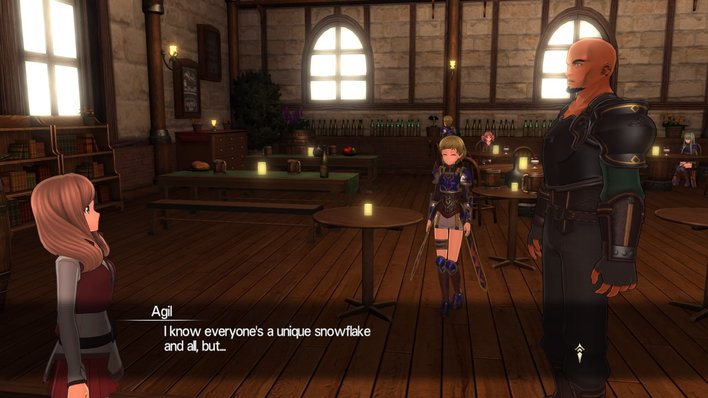
Agil seemingly doesn't think kindly of social justice warriors.
It may be a little muddled in its approach, but for those who have the patience to figure out its quirks, and for those who loved the anime series, Sword Art Online: Hollow Realization is far from a bad game. With a fun battle system, great characters and an intriguing offline/online setting, Hollow Realization is definitely worth a look if you like your Japanese role-playing games; even more so if you have some friends you can rope in too.
Format Reviewed: Playstation 4










